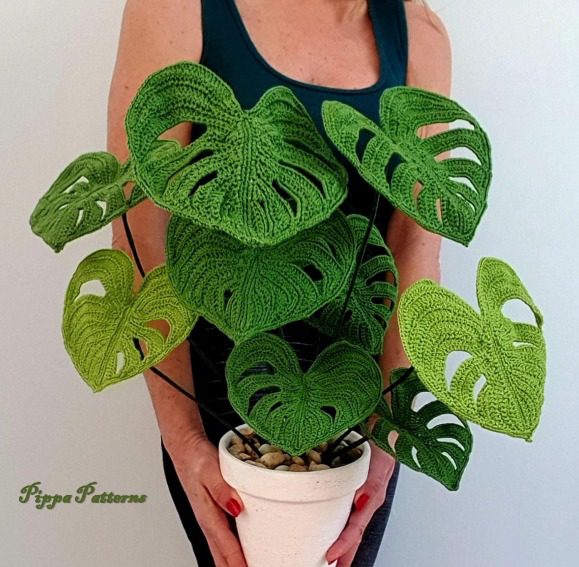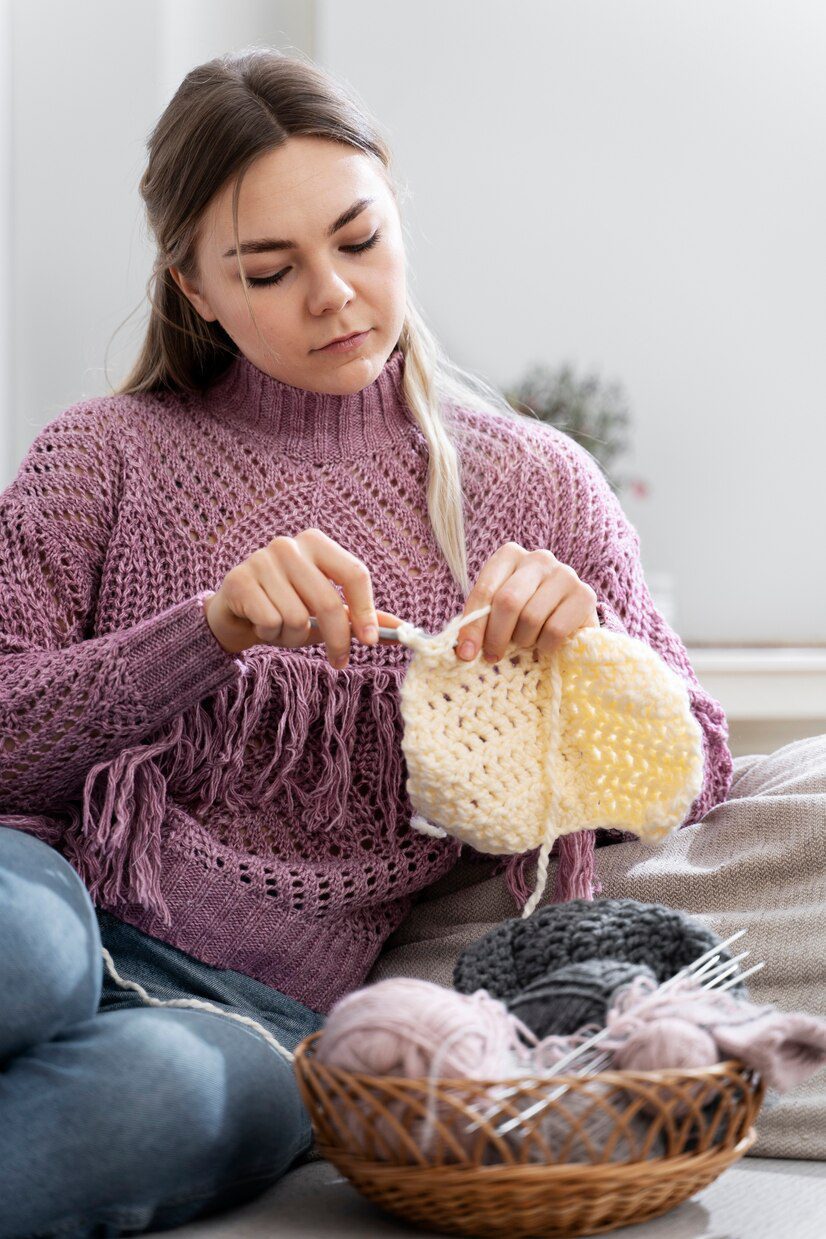Table of Contents
The Monstera deliciosa, known for its distinctive split leaves, has become an iconic houseplant in modern interior design. For plant enthusiasts who want a low-maintenance alternative that will never wilt, this crochet Monstera pattern offers the perfect solution. This comprehensive guide will walk you through creating a stunning, realistic Monstera plant with beautiful heart-shaped leaves featuring the characteristic fenestrations (holes) that make this plant so distinctive.
Monstera Materials Needed
For this crochet Monstera plant, you’ll need:
- Yarn: 3ply, crochet cotton10, 4ply or DK (specific recommendation: DMC Petra no5 and DMC Petra no3)
- Crochet hooks: 1.5mm, 2mm, and 2.5mm
- Garden wire: 3mm or 3.5mm (for the stem)
- Green floral tape
- Florist wire: 26 gauge (for leaves)
- Optional: Plant pot (6×6 inches/15×15cm)
- For potting: styrofoam or dry florist sponge, pebbles or soil for decorative covering
Sizing Information
The size of your finished leaves will depend on your yarn choice:
- Small leaves: 6×6 inches (15×15cm) using DMC Petra no5 with 1.5mm hook
- Medium leaves: 7×7 inches (18×18cm) using DMC Petra no3 or any 4ply yarn with 2mm hook
- Large leaves: 8×8 inches (20×20cm) using doubled DMC Petra no5 or any DK yarn with 2.5mm hook
The completed plant will stand approximately 21 inches (53cm) tall when made with 9 leaves: 2 large, 3 medium, and 4 small.
Understanding the Pattern
This pattern uses US terminology and is divided into sections to make it easier to follow. The leaf is created in two parts: first, you’ll crochet one side of the leaf down the center, working over a wire; then you’ll create the second side of the leaf.
Each section includes detailed instructions for creating different parts of the leaf’s distinctive shape. For the perfect Monstera look, you’ll work strategically placed increases and decreases, plus create chain spaces that will form the characteristic holes.
Creating the Base Row
Start by making a chain of 28 stitches. Cut a piece of florist wire approximately 16-18 inches (40-46cm) long and thread it through the stitch on your hook. Work over this wire as you create the base row:
- Chain 1
- Skip 1 stitch
- Work 26 single crochets over the wire
- Work 3 single crochets in the last chain, pulling the wire around equally as you work
- Pull the starting tail tight
At this point, you’ll have 27 stitches on each side plus an extra stitch at the tip of the leaf and the skipped chain at the base.
Working Section 1
The pattern forms the leaf in sections, starting from the tip and working down each side. Section 1 creates the pointed tip of the Monstera leaf:
Row 1 (Down): 1sc, 1hdc, 4dc, 2hdc, 1sc, TURN (do not chain 1) Row 2 (Up): Skip 1st stitch, 3sc, increase 1sc, 2sc, slip stitch, chain 1, TURN Row 3 (Down): Skip 1st stitch, 7sc, decrease 1sc through post of previous row and next chain over wire, 3sc over wire, TURN
Creating the Leaf’s Characteristic Holes
For the distinctive Monstera leaf holes, you’ll work with chain spaces in sections 2 through 5. For example, in Section 2:
Row 1 (Up): Skip 1st stitch, 1sc, work 1hdc and 1dc in same stitch, chain 8, 1sc in 8th stitch from hook, slip stitch and chain 1, TURN Row 2 (Down): Skip 1st stitch, 1sc, 8sc in chain space, 3sc, decrease 1sc through post and next chain, TURN
Each section follows this pattern, with variations in stitch counts and chain spaces to create differently sized holes.
Completing Both Sides of the Leaf
After finishing the first half of the leaf, you’ll work the second half following the same pattern but working into the 26 stitches along the base chain rather than over the wire. The pattern specifies:
“Start in the 1st chain on the other side and work 26sc, slip stitch, chain 1, TURN. Skip 1 stitch, then repeat Sections 1-5 for the second half of the leaf.”
Adding the Outer Wire
To give your Monstera leaf its realistic shape, you’ll add a second wire around the perimeter:
- Insert a second wire (approximately 32-38 inches/80-96cm depending on leaf size)
- Bend the first wire out of the way at the back of the leaf
- Work a round of stitches through the chains and posts all around the leaf, crocheting over this new wire
- When complete, shape the leaf by gently bending the wires
Creating the Stem and Assembling
For a natural-looking plant:
- Cut garden wire pieces of varying lengths (8-20 inches/20-50cm) for different leaves
- Tape the leaf stem to the garden wire with floral tape
- For support, attach a second piece of garden wire (4-6 inches/10-15cm) to the main stem
- Bend the stems slightly for a natural appearance
- If using a pot, insert the stems into styrofoam or florist sponge and cover with decorative pebbles or soil
Monstera Design Variations
The pattern offers options to customize your Monstera by changing the first two rows of various sections, creating different hole patterns and leaf shapes. These variations allow you to create a plant that’s uniquely yours while maintaining the characteristic Monstera appearance.
With patience and attention to detail, this crochet pattern enables you to create a stunning Monstera plant that captures the beauty of this popular houseplant without any of the maintenance. The realistic appearance comes from the carefully designed increases and decreases that form the leaf shape, the strategically placed holes, and the wire framework that allows you to position the leaves naturally.
Whether you’re an experienced crocheter looking for a challenge or an intermediate crafter ready to try something new, this Monstera pattern offers a rewarding project that will result in a beautiful, enduring plant for your home.Réessayer
Check this out : Crochet Cute Amigurumi Krosh and Star Characters
Conclusion
Creating a crocheted Monstera plant offers a rewarding experience for crafters seeking to bring botanical beauty into their home without the maintenance of live plants. This pattern, with its detailed instructions and strategic use of wires, allows you to capture the distinctive split leaves and unique characteristics that make Monstera plants so beloved in interior design. The ability to customize leaf sizes and create variations in the fenestration patterns means each finished project can be uniquely yours. With patience and attention to detail, you’ll craft a stunning, realistic plant that will become a long-lasting statement piece in your home. Unlike its living counterpart, your handmade Monstera will never wilt, need watering, or outgrow its space—making it a perfect forever plant for any environment. As you shape the wire-reinforced leaves and arrange your completed stems, you’ll gain not just a beautiful decorative item, but also the satisfaction of having created something truly special with your own hands.












Leave a Reply